
Margaretville is a village in Delaware County, New York, United States. The population was 596 at the 2010 census. The village is in the town of Middletown, on the border of the Catskill Park.

The East Branch Delaware River is one of two branches that form the Delaware River. It is approximately 75 mi (121 km) long, and flows through the U.S. state of New York. It winds through a mountainous area on the southwestern edge of Catskill Park in the Catskill Mountains for most of its course, before joining the West Branch along the northeast border of Pennsylvania with New York. Much of it is paralleled by State Route 30.
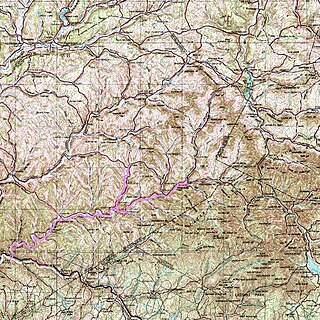
The Delaware and Northern Railroad was a small railroad in Delaware County, New York that was founded in 1905, and was planned to go from East Branch, where it would make a connection with the New York, Ontario and Western Railway, to Arkville, where it would connect with the Ulster and Delaware. This line ran close to the banks of the East Branch of the Delaware River, and had plans of expansion, but never made it far, only getting to Arkville. The line was scrapped in 1942, when the Pepacton Reservoir took over its right-of-way and forced the D&N to go out of business.
Downsville is a hamlet, census-designated place (CDP), and former village in the town of Colchester, Delaware County, New York, United States. The population was 617 at the 2010 census.

Tuscarora Club Bridge is a wooden covered bridge in the Town of Middletown, New York. It is one of 24 covered bridges in New York State. It is one of three that is less historic and is not landmarked.

The Grant Mills Bridge, officially the Millbrook Bridge, is a wooden covered bridge over Mill Brook in Hardenburgh, New York, United States. It is one of 29 covered bridges in the state.

Bruynswick School No. 8 is a former school located on Bruynswick Road in the small hamlet of the same name in the northwestern portion of Shawangunk, New York, United States. It is one of the few remainders of a time when Bruynswick was more populous.
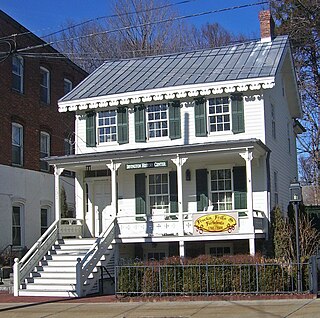
The McVickar House is located at 131 Main Street in Irvington, New York, United States. It is a wooden frame house built in the middle of the 19th century in the Greek Revival architectural style with some Picturesque decorative touches added later. In 2004 it was listed on the National Register of Historic Places.

The Galli-Curci Theatre is located on Main Street in Margaretville, New York, United States. It is a brick building erected in the 1920s, now primarily used as a store, although some of the original theater remains. It was named after opera singer Amelita Galli-Curci, who summered at her historic country estate near Margaretville from 1922-1937 and sang at its opening night.

The First Presbyterian Church of Margaretville, now Margaretville New Kingston Presbyterian Church, is located on Orchard Street in Margaretville, New York, United States. It is an ornate wooden church built late in the 19th century.

The Krom Stone House at 45 Upper Whitfield Road in the Ulster County Town of Rochester, New York, United States, is one of several houses associated with that family. It was built somewhere between 1680 and 1720.

Indian Rock Schoolhouse, also known as District 3 Schoolhouse or Webutuck Country Schoolhouse, is located on Mygatt Road in the hamlet of Amenia, New York, United States. It is a wooden one-room schoolhouse built in the mid-19th century in accordance with a standard state plan for small rural schools that reflected contemporary educational reform movements.
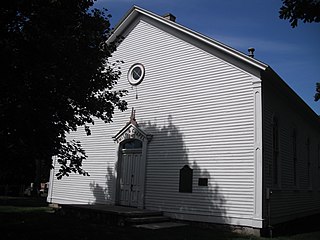
Smith's Chapel, also known as Smith Chapel, is a historic chapel located at 29858 Redfield Road in Milton Township, Cass County, Michigan, near Niles. It was designated a Michigan State Historic Site in 1979 and listed on the National Register of Historic Places in 1987. The chapel is the oldest known church building in Cass County, and probably the oldest in southwest Michigan.

The Tucker Mountain Schoolhouse is a historic one-room schoolhouse on Tucker Mountain Road in Andover, New Hampshire. The small wood-frame building was built in 1837, and served as a schoolhouse until 1893, when it was closed due to declining enrollments. The building was listed on the National Register of Historic Places in 2005. It is now owned by the Andover Historical Society, and is occasionally open to the public in the summer.
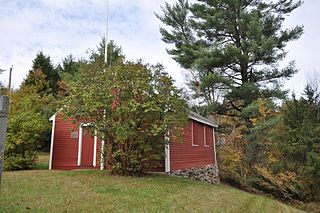
The Little Red School House, or the District No. 7 Schoolhouse, is a one-room schoolhouse on New Hampshire Route 10, south of downtown Newport, New Hampshire. Built in 1835, it is one of the state's few surviving pre-1850 district schoolhouses, and one of the least-altered of that group. It served the city as a school until 1891, and was acquired in 1951 by the local chapter of the Daughters of the American Revolution. It is open as a museum during the summer months. The building was listed on the National Register of Historic Places in 1980.

The Lincoln School is a historic former one-room schoolhouse at 8 Orchard Road in Acton, Maine. Built in 1884, it is the best-preserved of the town's surviving district school buildings, and was its last active district school, closed in 1957. It was listed on the National Register of Historic Places in 2013.
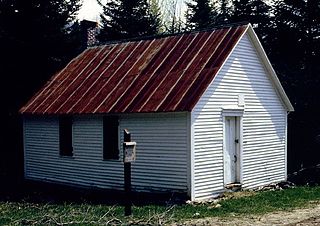
The District No. 1 Schoolhouse is a historic one-room schoolhouse on Somerset Road in Somerset, Vermont. Built about 1850, it is the only known entirely unaltered district schoolhouse in the state, and is probably the only surviving municipal building from the tiny community, which was disincorporated in 1937. The building was listed on the National Register of Historic Places in 1992.

The Brock Hill Schoolhouse is a historic one-room schoolhouse on North Road in rural Newbury, Vermont. Built in 1850, it is a well-preserved example of a mid-19th century schoolhouse with Greek Revival styling. It was listed on the National Register of Historic Places in 2003.

The Nottawa Stone School is a schoolhouse located at 26456 M-86 near Nottawa, Michigan. It was listed on the National Register of Historic Places in 1972.
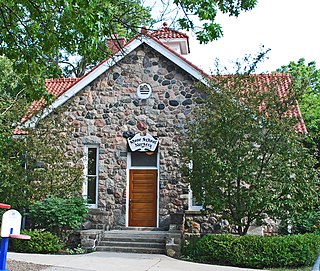
The Stone School is a school building located at 2600 Packard Road in Ann Arbor, Michigan. It was listed on the National Register of Historic Places in 1995. Beginning in 1955, the building houses the Stone School Cooperative Nursery.





















